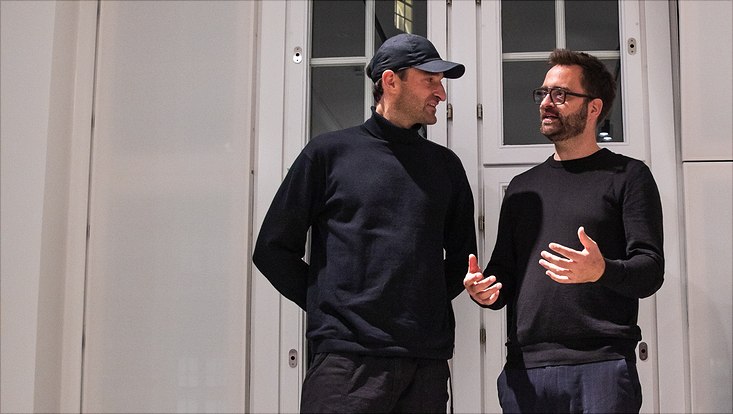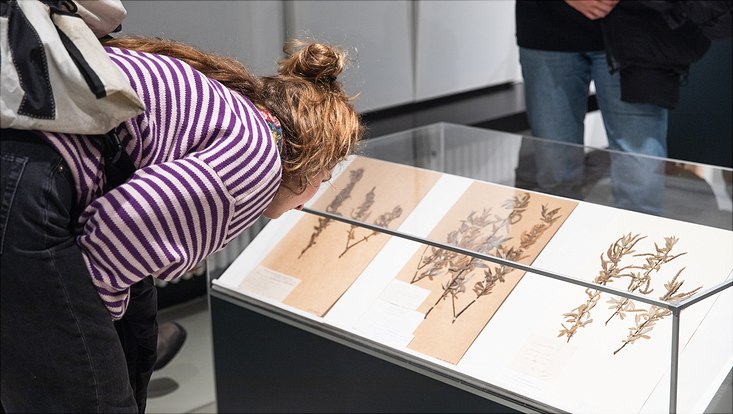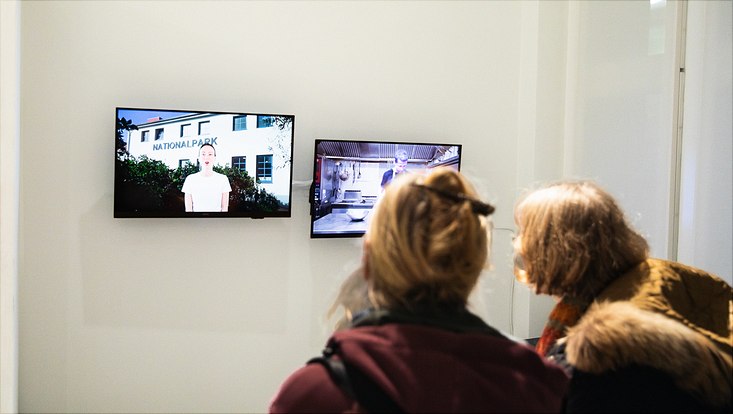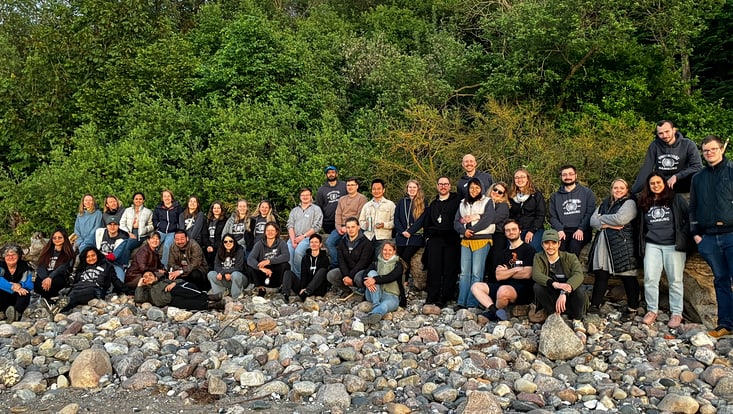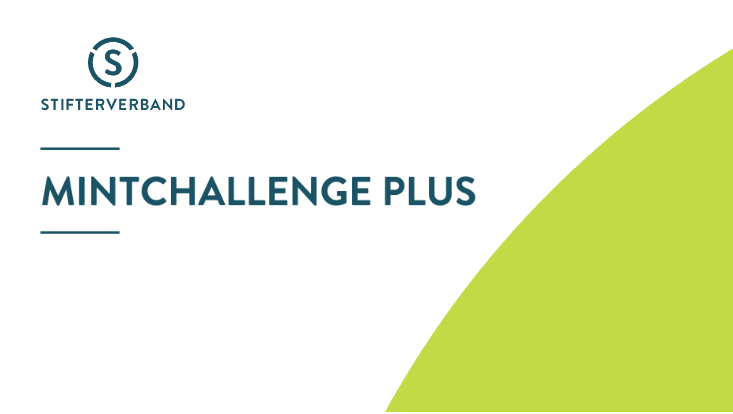and Society (CLICCS)
"Art has the power"
14 November 2024, by Stephanie Janssen

Photo: Uni Hamburg / L. Göttling
More than 240 people gathered before the doors of the University Museum, waiting to get in. November 7 was opening day for the exhibition “Portraits of Climate,” which combines art and climate research in unconventional ways and will continue through the end of April 2025.
-> Photo gallery at the end of the article.
The project, a brainchild of the Cluster of Excellence for climate research CLICCS, began roughly a year earlier, when mixed teams of two or three members from the art world and research community were formed. The teams have since created five works of art that portray climate change from a diverse range of perspectives.
During the opening ceremony, the Speaker for the Cluster of Excellence, Professor Johanna Baehr, reported that the roughly 270 experts working at the Cluster often break new, unknown scientific ground. They use a wide variety of approaches to build bridges, for example between the natural and social sciences. Researcher Dr. Anna Pagnone has now initiated a new way to reach society through art.
Pagnone’s goal is to shift boundaries, including those between disciplines. For example, the project has an internal effect, nudging the participants to abandon their normal roles and create something new together. But it can also produce an external effect, when visitors to the exhibit encounter the topic of climate change in a new and unexpected way. “Those of us working in the climate sciences often ask ourselves: are we satisfied with just passing on the information – or do we want to do something about it?,” she says. “Art has the power, the energy, that I wanted to inject into climate communications.”
This seems to work well on the first evening: “I feel invited to engage with the abstract world of climate research,” says one visitor. “I can see, feel and hear this world in the various themes. And the works touch me with their beauty and urgency.”
Another Award
Carl Maria Kemper, Dr. Jan Wilkens
The president of the 2023 UN Climate Conference in Dubai was the CEO of an oil company. While the cement company Holcim receives awards for being so green, the cement industry alone is responsible for eight percent of global CO2 emissions. As an expert on climate justice, Dr. Jan Wilkens is no stranger to these contradictions. Carl Maria Kemper’s “Another Award” shows just how entangled emissions-intensive sectors, climate impacts and climate justice are. Long after the flooding in the winter of 2023/2024, a flooding-prone area in Lower Saxony is still home to massive piles of sandbags. Cast in cement in the installation, they represent systematic oversights in prevention, a lack of resilience, and choosing to ignore the warnings voiced by researchers and activists alike. The work can also be viewed in the museum’s inner courtyard.
Journey Through Time and into the Future
Jenni Schurr, Dr. David Nielsen
When Arctic permafrost thaws due to climate change, it affects e.g. coastal regions. The once-frozen soil becomes soft and unstable, making it more vulnerable to erosion from wave action. At the same time, the waves grow stronger when the sea ice melts. Dr. David Nielsen calculated how much of the coast could be lost in this way in three scenarios, ranging from limited to extensive climate protection. On this basis, Jenni Schurr created a performance, in which three dancers represent the three scenarios. Initially dancing in harmony, their movements become increasingly chaotic – an apt representation of the impacts of global warming, accompanied by audio and video material from the Arctic – a “Journey Through Time and into the Future.”
Mysterium Völlii
Nana Petzet, Prof. Michael Köhl
In the 1970s, an area at the edge of Hamburg Harbor was created for industrial purposes using sludge from the harbor, but was never put to use – and today, 50 years later, it is home to the untouched forest Vollhöfner Wald. Slowly but surely, flora and fauna have taken over the area. As forestry researcher Prof. Michael Köhl knows, succession forests like this one can serve as role models for climate-stable and future-proof forests. In her contribution, Nana Petzet examines this “Mysterium Völlii” in detail, shows how different sections have developed differently, and highlights the amazing capabilities of soil – but also the battle to keep the forest, which began when logistics warehouses were to be built in its place. The protests were successful and plans to make the forest into a nature reserve were announced – but still haven’t been put into practice.
The Little Shrimps are Running Out of Space
Daniele Alef Grillo, Dr. Martin Döring
When it comes to snacks, the shrimp sandwich is a classic on the North Sea coast. Dr. Martin Döring’s research focuses on the cultural interplays between fishing, tradition and tourism. It’s only by considering and researching the entirety that sound solutions for adapting to changed climatic conditions can be found – locally and on the basis of consensus. In Daniele Alef Grillo’s video installation “The Little Shrimps are Running Out of Space,” an AI-generated female voice recites quotes from Döring’s interviews with fishers while we watch a cook in Turin making a shrimp sandwich. Though today shrimps have a role in our society, due to climate change, they’re gradually running out of space in the natural world.
Way of No Return
Dit Coesebrink, Dr. Cleovi Mosuela, Prof. Jörn Behrens
We see an expansive painting, and bit by bit the details are revealed – a mathematical formula in one spot, a pair of open hands in the corner. Mathematics professor Jörn Behrens works with formulas, while Dr. Cleovi Mosuela is investigating how local communities can shape their own adaptation to climate change. Dit Coesebrink presents fragments of their three-way conversations using the media of print, silkscreen and cyanotype. These fragments symbolize a permanent repetition of what was researched and said. At the same time, they hint at something more: that despite all the repetitions, societies and governments aren’t yet doing enough.
Exhibition “Portraits of Climate”
Art and Climate Research
Venue: University Museum, Edmund-Siemers-Allee 1, 20146 Hamburg; 1st floor
Exhibit: November 7, 2024 – April 30, 2025: Tue 10 am – 2 pm, Thu 3 pm – 7 pm, Sat 2 pm – 6 pm.
Additional information: “Portraits of Climate”
Supported by the University of Hamburg’s Transfer Agency and the University Museum as an innovative venue for knowledge transfer.
Contakt:
Dr. Anna Pagnone
Universität Hamburg
CLICCS - Exzellenzcluster für Klimaforschung
CEN - Centrum für Erdsystemforschung und Nachhaltigkeit
Tel.: +49 40 42838-7598
E-Mail: anna.pagnone"AT"uni-hamburg.de






